Suchergebnisse für "Factsheet: Energietechnologien gestalten, die für alle sinnvoll und nutzbar sind"
Highlights of Bioenergy Research 2020
January 24th, 2020
Messe Congress Graz, Messeplatz 1, 8010 Graz
National and international results from the IEA Bioenergy Tasks and the ERA-NET Bioenergy
Aktuelle Publikationen des IEA-SHC Tasks 49
Aktuelle Publikationen zum Thema "Solare Prozesswärme" jetzt online verfügbar.
Environmental, Material Flow and Sustainability Management Accounting - Offensive diffusion in adult education
Diffusion of the "Factory of Tomorrow" project line on environmental and material flow cost accounting (EMA and MFCA) for corporate and national system boundaries, as well as related tools for sustainability accounting in existing post graduate studies.
Strategic optimisation of the regulation of air moisture through ventilation systems to reduce energy demand for humidifiers and dehumidifiers
For the validation of coupled room and building component simulations, an analytical solution of this unsteady problem was developed. Finally, a simplified method for determining the humidification and dehumidification demands considering a room's effective moisture capacity was developed.
Ausschreibung Eco-Innovation
SCI_BIM - Scanning and data capturing for Integrated Resources and Energy Assessment using Building Information Modelling
The aim of the project is to increase the resources- and energy efficiency through coupling of various digital technologies and methods for data capturing (geometry and materials composition) and modelling (as-built BIM), as well as through gamification.
ModularHeatNet
The aim of the project is to support Ottensheim in phasing out fossil fuels and developing a "climate-neutral" heat supply. As a result, the community will receive a solid decision-making basis based on the technical, economic, organizational, and environmental comparison of the examined heat supply approaches.
Rückblick: IEA Vernetzungsworkshop 2011
Am 9ten März fand der jährliche Vernetzungsworkshop der nationalen Akteure innerhalb der IEA-Forschungskooperation statt. Mit ca. 50 TeilnehmerInnen war der Workshop ein voller Erfolg und bot den Anwesenden einen umfassenden Überblick über aktuelle Themen der Internationalen Energieagentur (IEA).
Ausschreibung: Einreichung von Demonstrationsprojekten
Bis 19. November 2010 können - in Ergänzung zur 2. Ausschreibung von "Haus der Zukunft Plus" - Projektanträge zu Plus-Energie-Gebäuden mit hoher Signal- und Multiplikationswirkung als Demonstrationsprojekte eingereicht werden.
Gebäudeinnovationen aus Österreich
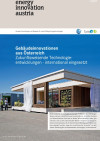
Zukunftsweisende Technologieentwicklungen - international eingesetzt
energy innovation austria
1/2017
Herausgeber: BMVIT und Klima- und Energiefonds
Deutsch, 8 Seiten
Downloads zur Publikation
Zukunftstechnologie Solarthermie
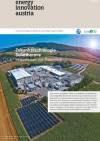
Zukunftstechnologie Solarthermie - Innovationen aus Österreich
energy innovation austria
1/2016
Herausgeber: BMVIT und Klima- und Energiefonds
Deutsch, 8 Seiten
Downloads zur Publikation
IEA EBC Annex 63 publiziert drei neue Berichte
Im IEA EBC Annex 63 "Umsetzung von Energiestrategien in Gemeinden" wurden 2017 drei Berichte publiziert.
IEA Bioenergy
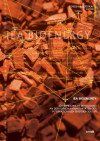
Österreichische Beteiligung an den Forschungsaktivitäten der internationalen Energieagentur
Forschungsforum
4/2000
Herausgeber: BMVIT
Deutsch, 6 Seiten
Downloads zur Publikation
TU Wien eröffnet Österreichs 1. Plus-Energie-Bürohochhaus
Am 6. November 2014 wurde das sanierte Plus-Energie-Bürohochhaus der TU Wien am Getreidemarkt feierlich eröffnet. Bundesminister Alois Stöger übergab im Rahmen der Zeremonie Urkunden zur Auszeichnung der Bearbeiter des "Haus der Zukunft"-Forschungs- und Demonstrationsprojekts.
Preisverleihung des Wettbewerbs "Intelligente Anwendungen Nachwachsender Rohstoffe"
6. May 2003
Tech Gate Vienna, Konferenzsaal, Ebene 0 / Gate 3
Wien, AT
Preisverleihung des Wettbewerbs im Rahmen der Programmlinie "Fabrik der Zukunft" durch Herrn Bundesminister Hubert Gorbach
Photovoltaik In Gebäuden
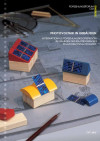
Internationale Forschungskooperation im Rahmen des IEA-Programms "SOLAR HEATING & COOLING"
Forschungsforum
1/1997
Herausgeber: BMVIT
Deutsch, 6 Seiten
Downloads zur Publikation
SPOT – Smart Parking Space Optimization Tool
SPOT develops a data-driven tool for demand-oriented optimization of parking spaces in urban areas to use space more efficiently and promote climate neutrality. The tool supports cities in reducing parking areas and creating green spaces by calculating evidence-based parking space ratios.
ReSpace – Reclaiming Spaces
ReSpace is developing an AI-based model for identifying, categorizing, and activating sealed areas. Existing data sources (aerial and satellite images, mobile network data, land registry entries) are integrated and enhanced with dynamic analysis to derive evidence-based recommendations for action.
Windenergie In Österreich
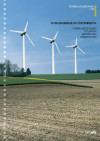
Voraussetzungen, Situation, Bewertung, Perspektiven
Forschungsforum
1/1995
Herausgeber: BMVIT
Deutsch, 6 Seiten
Downloads zur Publikation
Energie-Spar-Netzwerk
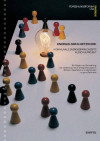
Kommunale Energiesparkonzepte als Schulprojekt
Forschungsforum
1/1994
Herausgeber: BMVIT
Deutsch, 6 Seiten
